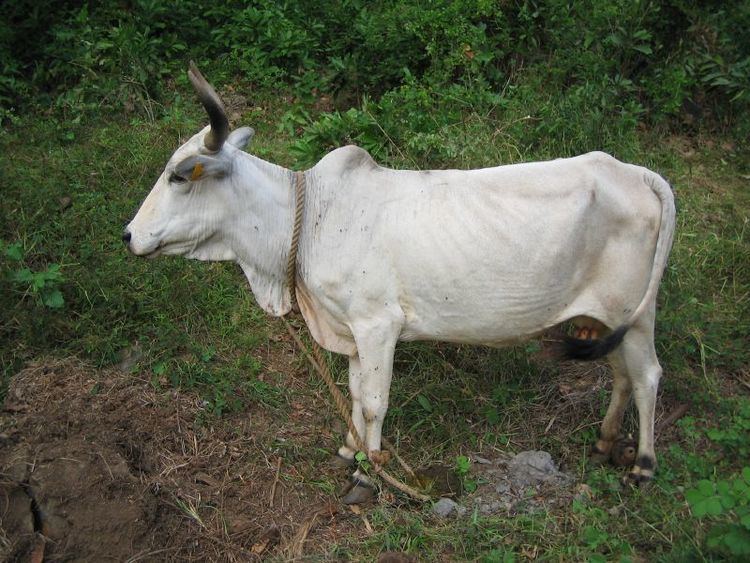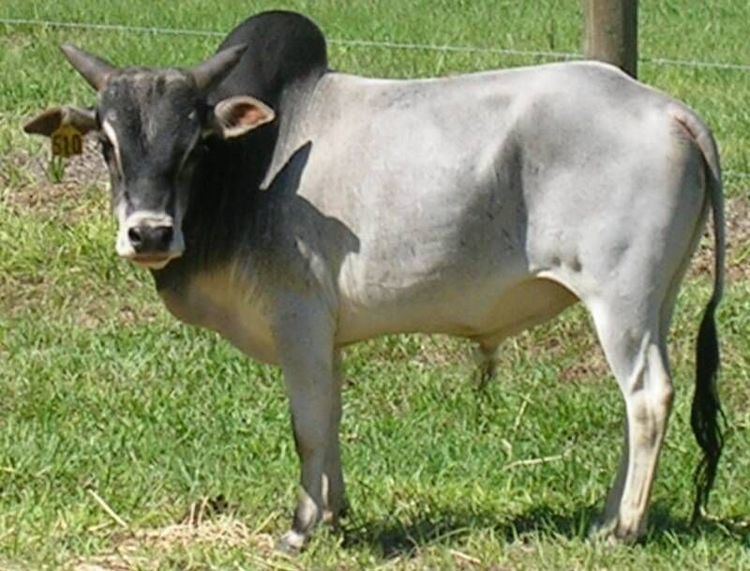Order Artiodactyla Higher classification Cattle | Phylum Chordata Genus Bos Rank Subspecies | |
 | ||
Mass Brahman: 800 – 1,100 kg, Gyr cattle: 540 kg, Ongole cattle: 430 – 460 kg Breeds Brahman, Gyr cattle, Nelore, Guzerat, Red Sindhi | ||
Petting zoo animal hates kids zebu
A zebu (/ˈziːˌbjuː/, /ˈziːbuː/ or /ˈzeɪbuː/; Bos primigenius indicus or Bos indicus or Bos taurus indicus), sometimes known as indicine cattle or humped cattle, is a species or subspecies of domestic cattle originating in South Asia. Zebu are characterised by a fatty hump on their shoulders, a large dewlap, and sometimes drooping ears. They are well adapted to withstanding high temperatures, and are farmed throughout the tropical countries, both as pure zebu and as hybrids with taurine cattle, the other main type of domestic cattle. Zebu are used as draught oxen, dairy cattle, and beef cattle, as well as for byproducts such as hides and dung for fuel and manure. In 1999, researchers at Texas A&M University successfully cloned a zebu.
Contents
- Petting zoo animal hates kids zebu
- Zebu cattle at sharjah animal market 21 11 2012
- Taxonomy and etymology
- Origin
- Breeds and hybrids
- Characteristics
- Reproduction
- Uses
- References

Zebu cattle at sharjah animal market 21 11 2012
Taxonomy and etymology
The scientific name of zebu cattle was originally Bos indicus, but they are now more commonly classified within the species Bos taurus as B. t. indicus, together with taurine cattle (B. t. taurus) and the extinct ancestor of both of them, the aurochs (B. t. primigenius). Taurine ("European") cattle are descended from the Eurasian aurochs, while zebu are descended from the Indian aurochs. "Zebu" may be either singular or plural, but "zebus" is also an acceptable plural form. The Spanish name, cebu or cebú, is also present in a few English works.
Origin

Zebu cattle are thought to be derived from Indian aurochs, sometimes regarded as a subspecies, B. p. namadicus Wild Asian aurochs disappeared during the time of the Indus Valley Civilisation from its range in the Indus River basin and other parts of South Asia possibly due to interbreeding with domestic zebu and resultant fragmentation of wild populations due to loss of habitat.
Archaeological evidence including pictures on pottery and rocks suggests that the species were present in Egypt around 2000 BC and were thought to be imported from the near east or south. Bos indicus is believed to have first appeared in sub-Saharan Africa between 700 and 1500 and was introduced to the Horn of Africa around 1000.
Breeds and hybrids
Some 75 breeds of zebu are known, split about evenly between African breeds and South Asian ones. The major zebu cattle breeds of the world include Gyr, Kankrej and Guzerat, Indo-Brazilian, Brahman, Nelore, Ongole, Sahiwal, Red Sindhi, Butana and Kenana, Boran, Baggara, Tharparkar, Kangayam, Southern Yellow, Kedah-Kelantan, and Local Indian Dairy (LID). Kedah-Kelantan and LID originated from Malaysia. Other breeds of zebu are quite local, like the Hariana of Haryana and eastern Punjab or the Rath of Alwar in eastern Rajasthan.
The African sanga cattle breeds originated from hybridization of zebu with indigenous African humpless cattle; they include the Afrikaner, Red Fulani, Ankole-Watusi, and many other breeds of central and southern Africa. Sanga cattle can be distinguished from pure zebu by having smaller humps located farther forward on the animals.
Zebu were imported to Africa over many hundreds of years, and interbred with taurine cattle there. Genetic analysis of African cattle has found higher concentrations of zebu genes all along the east coast of Africa, with especially pure cattle on the island of Madagascar, either implying that the method of dispersal was cattle transported by ship or alternatively, the zebu may have reached East Africa via the coastal route (Pakistan, Iran, Southern Arabian coast) much earlier and crossed over to Madagascar. Partial resistance to rinderpest led to another increase in the frequency of zebu in Africa.
Zebu, which can tolerate extreme heat, were imported into Brazil in the early 20th century and crossbred with Charolais cattle, a European taurine breed. The resulting breed, 63% Charolais and 37% zebu, is called the Canchim. It has a better meat quality than the zebu and better heat resistance than European cattle. The zebu breeds used were primarily Indo-Brazilian with some Nelore and Guzerat.
Many breeds are complex mixtures of the zebu and various taurine types, and some also have yak, gaur, or banteng genes. While zebu are the common cattle in much of Asia, the cattle of Japan, Korea, and Mongolia are taurine (although possibly domesticated separately from the other taurine cattle originating from Europe and Africa). Other species of cattle domesticated in parts of Asia include yak, gaur, banteng, and water buffalo.
Han-u is a traditional Korean taurine–zebu hybrid breed.
Characteristics
Zebu have humps on the shoulders, large dewlaps, and droopy ears. They are adapted to the harsh environment of the tropics. Adaptations include resistance to disease and tolerance of intense heat, sun, and humidity.
Reproduction
Zebu are generally mature enough to begin reproducing around 44 months old. This is based on the development of their bodies to withstand the strain of carrying and lactation. Early reproduction can place too much stress on the body and possibly shorten lifespans. Carrying time of the calf averages at 285 days, but varies depending on the age and nutrition of the mother. The sex of the calf may also affect the carrying time, as male calves are carried for a shorter period than females. Location, breed, body weight, and season affect the overall health of the animal and in return may also affect the carrying period.
Uses
Zebu are used as draught oxen, dairy cattle, and beef cattle, as well as for byproducts such as hides, dung for fuel and manure, and bone for knife handles and the like.
B. indicus cows commonly have low production of milk. They do not produce milk until maturation later in their lives and do not produce much, giving it solely to their calves. When B. indicus is crossed with B. taurus, production generally increases.
Genetic analysis has shown that the αS1 gene is most likely to have originated in B. indicus
